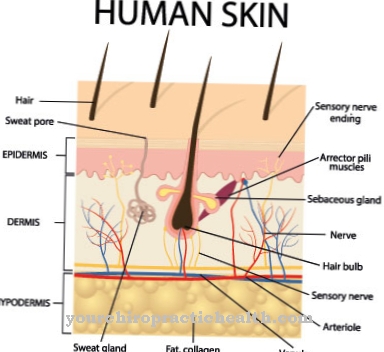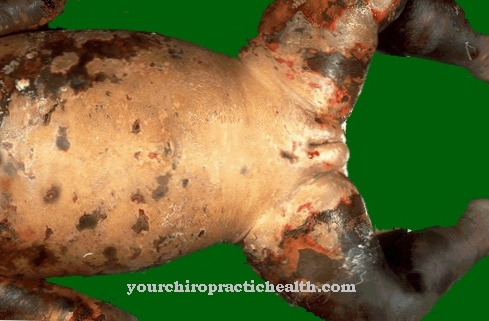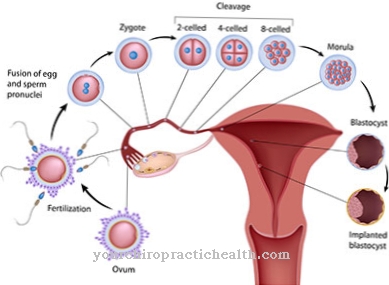At the Keratoconus it is a progressive thinning and deformation of the cornea of the eye. The cornea protrudes in a cone shape. Keratoconus is often accompanied by other diseases and, to some extent, by genetic disorders.
What is Keratoconus?

© sakurra - stock.adobe.com
A Keratoconus is characterized by the conical deformation and thinning of the cornea of the eye. Both eyes are always affected. However, the extent of the deformation may differ in both eyes. The disease usually only begins in one eye. A little later it spreads to the other eye. The keratoconus is characterized by two important characteristics.
On the one hand, the cornea becomes thinner and more pointed, and on the other hand, visual acuity decreases steadily over time. Patients become myopic. A complete compensation with a visual aid is not possible. This is due to the irregular protrusion of the cornea. The curvature of the cornea is also known as astigmatism. Keratoconus can be intermittent.
But there are also cases with a flowing and continuous protrusion of the cornea. The disease is very rare. In the West, one in 1,000 to 2,000 people gets keratoconus. Around 40,000 people are affected in Germany. However, the prevalence is slightly higher in the Middle East. The disease usually begins between the ages of 20 and 30. However, it can also occur much earlier (in childhood) or much later (between the ages of 40 and 50).
causes
The causes of keratoconus are not fully understood. There is evidence that it occurs in connection with certain genetic diseases such as Down syndrome, monosomy X, Ehlers-Danlos syndrome or Marfan syndrome. The development of keratoconus has also been observed in the context of atopic eczema, hay fever or other allergic diseases.
Structural studies of the cornea have shown changes. The arrangement of the individual collagen lamellae is probably destroyed by a proteolytic breakdown process. Several causes can lead to this. Either there are genetic changes or the eye is influenced by various external loads such as strong rubbing or environmental factors.
At least these factors act like an initial event. The eye pressure increases and the tissue weakness of the cornea increases further. As a result, the curvature of the cornea continues to increase. A cycle is set in motion that is very difficult to stop. The disease can become acute when it comes to tears in the back cornea. Then fluid enters the anterior chamber of the eye, which manifests itself in a rapid clouding of the cornea. In this case, the patients can only see through fog. However, this so-called hydrops regresses on its own.
Symptoms, ailments & signs
The keratoconus begins insidiously. Those affected have to constantly adjust their glasses. Sometimes you see things twice. Sometimes this can only be in one eye. Furthermore, shadows appear on objects and letters as well as star-shaped rays and streaks from light sources. Keratoconus lines appear with a yellow-brown or green-brown color, which completely or semicircularly surround the corneal cone.
Furthermore, there may be tears in Descemet's membrane, which become visible as so-called Vogt lines. In the advanced stage, acute keratoconus often forms, which is water retention in the cornea. This heals after a few months with scarring. The keratoconus is divided into four stages, which document the extent of corneal thinning and corneal curvature.
Important symptoms of the disease are the appearance of ghost images when seeing, multiple images, distortions, constantly reddened eyes, tense facial muscles, intolerance to cold, dry or stuffy air, sensitivity to light, seeing halos, limited vision at night, changes in position or even falling out of the contact lenses , Stargazing and streaks while reading. Allergies, asthma, rheumatism, neurodermatitis or dry eyes are often observed as concomitant diseases.
Diagnosis & course of disease
Keratoconus can often only be diagnosed after a noticeable nearsightedness has developed. Sometimes the diagnosis is also made as part of a routine examination by the ophthalmologist. Symptoms of the disease result from frequent adjustment of glasses. However, the cause of these eye problems is often not immediately recognized because keratoconus is very rare.
A retinoscope is available as a diagnostic device, which can detect the well-known fish mouth effect in keratoconus. Various devices are also used to measure the corneal radii, corneal layers or corneal thickness. In addition, the surface structure of the cornea is recorded and the cross-section of the anterior segment of the eye recorded.
Complications
As a rule, keratoconus causes discomfort in the eyes. The affected person mainly suffers from visual problems and in the worst case can even go completely blind. The cornea is also damaged. The complaints significantly limit the quality of life and everyday life of the person affected.
It is not uncommon for visual problems to lead to psychological disorders or to depression. Young people in particular often suffer from severe vision loss. In most cases, night blindness also occurs. The patients also suffer from an increased sensitivity to light and are therefore restricted in their everyday life. There is also veil vision. As a result, in some cases the person concerned can no longer carry out his professional activity, also because those usually struggle with a reduction in concentration.
In some cases, direct treatment is not necessary and the sufferer can use contact lenses to compensate for the discomfort. Operations with a laser can also be carried out. In most cases, these only take place in adulthood. There are no particular complications and the life expectancy of the patient is not reduced by this disease.
When should you go to the doctor?
As a rule, a doctor should be consulted in any case with keratoconus. In the worst case, the disease can lead to the death of the person concerned. Early diagnosis and treatment have a positive effect on the further course of the disease. See a doctor if the person's eyesight changes frequently and gets worse over time.
Double vision or blurred vision can also indicate keratoconus and should be examined by a doctor. In many cases, the affected person's cornea turns green or yellow. The eyes are reddened and objects may appear distorted or deformed. If these symptoms persist and do not go away on their own, you should definitely consult a doctor. Asthma can also indicate keratoconus.
An ophthalmologist should always be consulted with this disease. In acute emergencies, those affected can go to a hospital. The life expectancy of the patient is not negatively affected by the disease.
Therapy & Treatment
Treatment for keratoconus consists of constantly adjusting glasses or inserting contact lenses. There is still no consensus on the best treatment method. With contact lenses it can happen that they slip or even fall out if the cornea has already changed further. Some doctors therefore try to regulate the problems by constantly correcting their glasses.
According to unconfirmed observations, contact lenses are said to accelerate the curvature of the cornea. However, other doctors have also reported the opposite. The use of contact lenses should stop the curvature. Many different contact lenses are used. In individual cases, a corneal transplant is also carried out.
You can find your medication here
➔ Medicines for eye infectionsOutlook & forecast
The everyday life of those affected is often affected by symptoms such as sensitivity to glare, double vision and rapidly changing eyesight. The latter often happens within a few days, which means that correcting the eyesight with glasses only leads to short-term success. In order to compensate for this deficit, it helps to have glasses in different prescriptions in stock and to use them as needed.
After consultation with the attending physician, there is also the option of combining contact lenses with existing glasses and thus being able to react quickly and extremely flexibly to a change in vision. Due to the increased risk of infection with keratoconus, absolute hygiene and regular change of contact lenses must be ensured.
Changes within the apartment also enable a further increase in the quality of life. For this it is necessary to eliminate possible sources of interference. Incorrectly placed lamps or light sources that are too bright lead to unpleasant streaks in the field of vision for many of those affected or to unpleasant glare due to the high sensitivity to light. If these effects occur in the workplace, the patient must not be afraid to speak to his supervisor about this and work with him to develop an opportunity to remedy the situation. Otherwise, the workforce is in some cases significantly restricted by a reduction in the ability to concentrate and can lead to incapacity for work at this workplace.
prevention
Since the exact causes of keratoconus are not known, no specific recommendations can be given for its prophylaxis. In general, however, those affected are advised to drink a lot and to exercise frequently in the fresh air.
Aftercare
Follow-up care for keratoconus is closely related to prevention. Among other things, those affected should drink enough fluids and go into the fresh air to protect their eyes. The frequent changes in eyesight can be mitigated in everyday life by switching off sources of interference. For this it is helpful to adapt the working and living environment accordingly.
Too bright light or poor lighting increase the feeling of not being able to see properly. With better lighting, however, patients no longer feel as badly impaired. In order to compensate for the varying visual acuity, it is also advisable to use several glasses.
This makes it easier for the patient to deal with the visual problems. However, an exact consultation with the ophthalmologist is necessary. If necessary, he or she can speak to an optician to find a satisfactory solution for those affected. He may even recommend the combination of glasses and contact lenses.
Proper eye hygiene is also very important. By taking the appropriate measures, patients can take care of their eyes and protect them from possible inflammation. This avoids the negative effects of infections on eyesight.
You can do that yourself
Patients with keratoconus suffer from the often rapidly varying eyesight and various symptoms such as sensitivity to glare and double vision, which can interfere with everyday life. In order to maintain the accustomed quality of life, patients first try to adapt their living environment to the illness and to eliminate certain sources of interference. These include, for example, lamps that are attached in an inconvenient position or that are simply too bright, which leave streaks in the field of vision in many patients with keratoconus and are also unsuitable due to their sensitivity to glare.
Since the visual acuity of those affected often changes within days, both in the direction of improvement and deterioration, the possession of several glasses makes it easier to deal with the disease. Some people even combine contact lenses with glasses, although such practices must always be clarified with the treating ophthalmologist and, if necessary, also with the optician. In this way, the patients are able to react flexibly to the variable visual acuity.
In addition, hygiene in the eye area plays a relevant role in maintaining the health of the organs of vision and thus the general well-being of the patient. With appropriate hygienic measures, those affected protect their eyes from infections, which may have a negative effect on the course of the keratoconus.

.jpg)


.jpg)






















